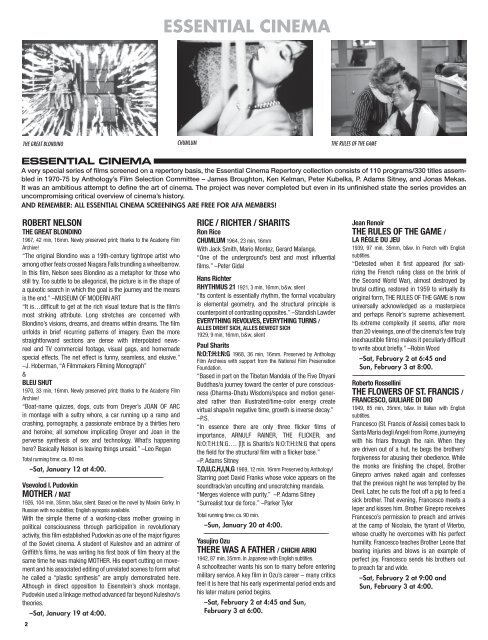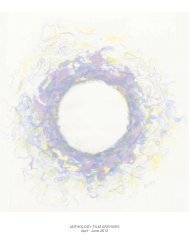quarterly pdf - Anthology Film Archives
quarterly pdf - Anthology Film Archives
quarterly pdf - Anthology Film Archives
You also want an ePaper? Increase the reach of your titles
YUMPU automatically turns print PDFs into web optimized ePapers that Google loves.
2<br />
ESSENTIAL CINEMA<br />
CHUMLUM<br />
THE GREAT BLONDINO THE RULES OF THE GAME<br />
ESSENTIAL CINEMA<br />
A very special series of films screened on a repertory basis, the Essential Cinema Repertory collection consists of 110 programs/330 titles assembled<br />
in 1970-75 by <strong>Anthology</strong>’s <strong>Film</strong> Selection Committee – James Broughton, Ken Kelman, Peter Kubelka, P. Adams Sitney, and Jonas Mekas.<br />
It was an ambitious attempt to define the art of cinema. The project was never completed but even in its unfinished state the series provides an<br />
uncompromising critical overview of cinema’s history.<br />
AND REMEMBER: ALL ESSENTIAL CINEMA SCREENINGS ARE FREE FOR AFA MEMBERS!<br />
ROBERT NELSON<br />
THE GREAT BLONDINO<br />
1967, 42 min, 16mm. Newly preserved print; thanks to the Academy <strong>Film</strong><br />
Archive!<br />
“The original Blondino was a 19th-century tightrope artist who<br />
among other feats crossed Niagara Falls trundling a wheelbarrow.<br />
In this film, Nelson sees Blondino as a metaphor for those who<br />
still try. Too subtle to be allegorical, the picture is in the shape of<br />
a quixotic search in which the goal is the journey and the means<br />
is the end.” –MUSEUM OF MODERN ART<br />
“It is…difficult to get at the rich visual texture that is the film’s<br />
most striking attribute. Long stretches are concerned with<br />
Blondino’s visions, dreams, and dreams within dreams. The film<br />
unfolds in brief recurring patterns of imagery. Even the more<br />
straightforward sections are dense with interpolated newsreel<br />
and TV commercial footage, visual gags, and homemade<br />
special effects. The net effect is funny, seamless, and elusive.”<br />
–J. Hoberman, “A <strong>Film</strong>makers <strong>Film</strong>ing Monograph”<br />
&<br />
BLEU SHUT<br />
1970, 33 min, 16mm. Newly preserved print; thanks to the Academy <strong>Film</strong><br />
Archive!<br />
“Boat-name quizzes, dogs, cuts from Dreyer’s JOAN OF ARC<br />
in montage with a sultry whore, a car running up a ramp and<br />
crashing, pornography, a passionate embrace by a thirties hero<br />
and heroine; all somehow implicating Dreyer and Joan in the<br />
perverse synthesis of sex and technology. What’s happening<br />
here? Basically Nelson is leaving things unsaid.” –Leo Regan<br />
Total running time: ca. 80 min.<br />
–Sat, January 12 at 4:00.<br />
–––––––––––––––––––––––––––––––––––––––––––––––––––––––––––––––––––––––––––––––––––––––––––<br />
Vsevolod I. Pudovkin<br />
MOTHER / MAT<br />
1926, 104 min, 35mm, b&w, silent. Based on the novel by Maxim Gorky. In<br />
Russian with no subtitles; English synopsis available.<br />
With the simple theme of a working-class mother growing in<br />
political consciousness through participation in revolutionary<br />
activity, this film established Pudovkin as one of the major figures<br />
of the Soviet cinema. A student of Kuleshov and an admirer of<br />
Griffith’s films, he was writing his first book of film theory at the<br />
same time he was making MOTHER. His expert cutting on movement<br />
and his associated editing of unrelated scenes to form what<br />
he called a “plastic synthesis” are amply demonstrated here.<br />
Although in direct opposition to Eisenstein’s shock montage,<br />
Pudovkin used a linkage method advanced far beyond Kuleshov’s<br />
theories.<br />
–Sat, January 19 at 4:00.<br />
RICE / RICHTER / SHARITS<br />
Ron Rice<br />
CHUMLUM 1964, 23 min, 16mm<br />
With Jack Smith, Mario Montez, Gerard Malanga.<br />
“One of the underground’s best and most influential<br />
films.” –Peter Gidal<br />
Hans Richter<br />
RHYTHMUS 21 1921, 3 min, 16mm, b&w, silent<br />
“Its content is essentially rhythm, the formal vocabulary<br />
is elemental geometry, and the structural principle is<br />
counterpoint of contrasting opposites.” –Standish Lawder<br />
EVERYTHING REVOLVES, EVERYTHING TURNS /<br />
ALLES DREHT SICH, ALLES BEWEGT SICH<br />
1929, 9 min, 16mm, b&w, silent<br />
Paul Sharits<br />
N:O:T:H:I:N:G 1968, 36 min, 16mm. Preserved by <strong>Anthology</strong><br />
<strong>Film</strong> <strong>Archives</strong> with support from the National <strong>Film</strong> Preservation<br />
Foundation.<br />
“Based in part on the Tibetan Mandala of the Five Dhyani<br />
Buddhas/a journey toward the center of pure consciousness<br />
(Dharma-Dhatu Wisdom)/space and motion generated<br />
rather than illustrated/time-color energy create<br />
virtual shape/in negative time, growth is inverse decay.”<br />
–P.S.<br />
“In essence there are only three flicker films of<br />
importance, ARNULF RAINER, THE FLICKER, and<br />
N:O:T:H:I:N:G…. [I]t is Sharits’s N:O:T:H:I:N:G that opens<br />
the field for the structural film with a flicker base.”<br />
–P. Adams Sitney<br />
T,O,U,C,H,I,N,G 1969, 12 min, 16mm Preserved by <strong>Anthology</strong>!<br />
Starring poet David Franks whose voice appears on the<br />
soundtrack/an uncutting and unscratching mandala.<br />
“Merges violence with purity.” –P. Adams Sitney<br />
“Surrealist tour de force.” –Parker Tyler<br />
Total running time: ca. 90 min.<br />
–Sun, January 20 at 4:00.<br />
–––––––––––––––––––––––––––––––––––––––––––––––––––––––––––––––––––––––––––––––––––––––––––<br />
Yasujiro Ozu<br />
THERE WAS A FATHER / CHICHI ARIKI<br />
1942, 87 min, 35mm. In Japanese with English subtitles.<br />
A schoolteacher wants his son to marry before entering<br />
military service. A key film in Ozu’s career – many critics<br />
feel it is here that his early experimental period ends and<br />
his later mature period begins.<br />
–Sat, February 2 at 4:45 and Sun,<br />
February 3 at 6:00.<br />
Jean Renoir<br />
THE RULES OF THE GAME /<br />
LA RÈGLE DU JEU<br />
1939, 97 min, 35mm, b&w. In French with English<br />
subtitles.<br />
“Detested when it first appeared (for satirizing<br />
the French ruling class on the brink of<br />
the Second World War), almost destroyed by<br />
brutal cutting, restored in 1959 to virtually its<br />
original form, THE RULES OF THE GAME is now<br />
universally acknowledged as a masterpiece<br />
and perhaps Renoir’s supreme achievement.<br />
Its extreme complexity (it seems, after more<br />
than 20 viewings, one of the cinema’s few truly<br />
inexhaustible films) makes it peculiarly difficult<br />
to write about briefly.” –Robin Wood<br />
–Sat, February 2 at 6:45 and<br />
Sun, February 3 at 8:00.<br />
––––––––––––––––––––––––––––––––––––––––––––––––––––––––––––––––––––––––––––––––––<br />
Roberto Rossellini<br />
THE FLOWERS OF ST. FRANCIS /<br />
FRANCESCO, GIULIARE DI DIO<br />
1949, 85 min, 35mm, b&w. In Italian with English<br />
subtitles.<br />
Francesco (St. Francis of Assisi) comes back to<br />
Santa Maria degli Angeli from Rome, journeying<br />
with his friars through the rain. When they<br />
are driven out of a hut, he begs the brothers’<br />
forgiveness for abusing their obedience. While<br />
the monks are finishing the chapel, Brother<br />
Ginepro arrives naked again and confesses<br />
that the previous night he was tempted by the<br />
Devil. Later, he cuts the foot off a pig to feed a<br />
sick brother. That evening, Francesco meets a<br />
leper and kisses him. Brother Ginepro receives<br />
Francesco’s permission to preach and arrives<br />
at the camp of Nicolaio, the tyrant of Viterbo,<br />
whose cruelty he overcomes with his perfect<br />
humility. Francesco teaches Brother Leone that<br />
bearing injuries and blows is an example of<br />
perfect joy. Francesco sends his brothers out<br />
to preach far and wide.<br />
–Sat, February 2 at 9:00 and<br />
Sun, February 3 at 4:00.




